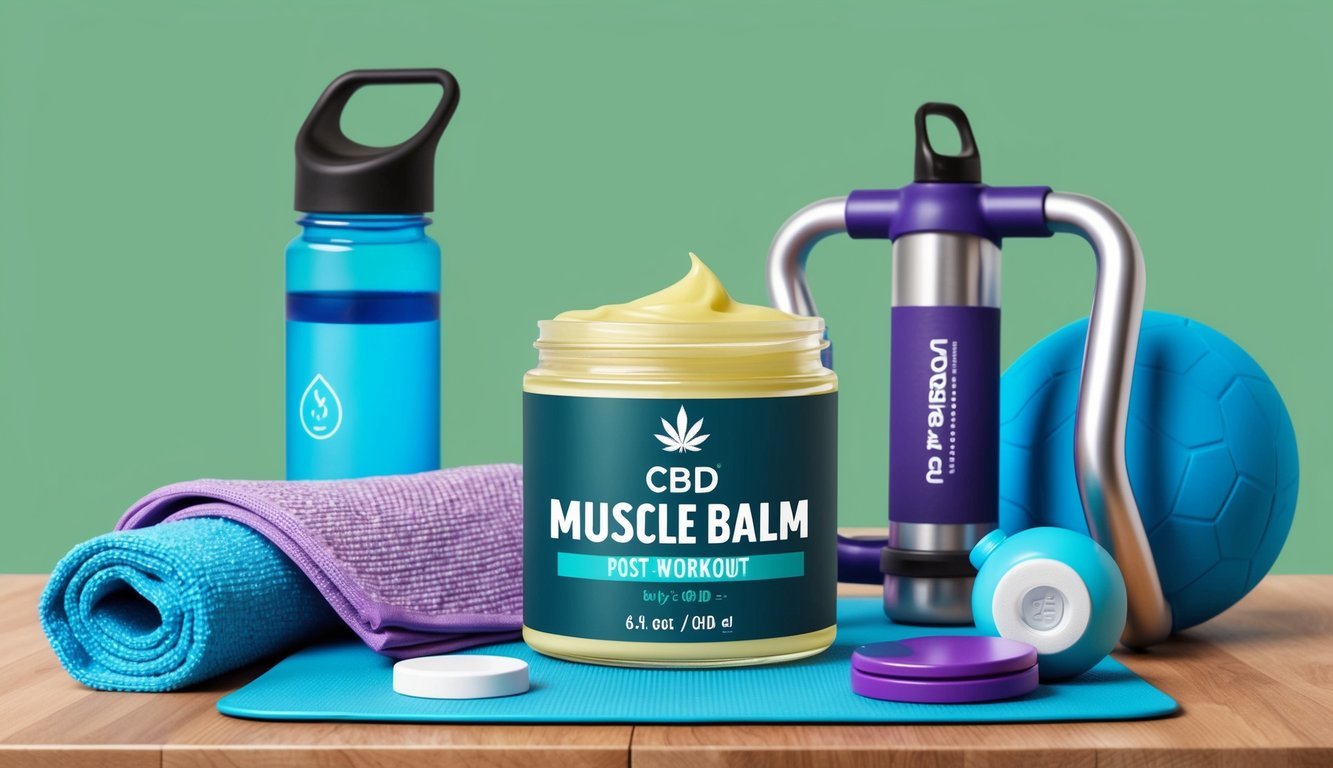After a tough workout, I’ve often found myself battling sore muscles.
It’s a common experience for anyone pushing their limits, and it can really affect how I feel in the days that follow. Finding effective ways to reduce this soreness can make all the difference in maintaining my workout routine and staying active.

I’ve learned that there are several solutions out there to tackle post-workout discomfort.
Whether it’s adjusting my recovery methods or incorporating new techniques, making a few changes can help me bounce back faster and feel better overall.
Looking for ways to ease that muscle pain? Let’s explore some practical tips that have worked for me.
Foam Rolling Session
I often turn to foam rolling after my workouts to help ease muscle soreness.
It’s a simple way to relieve tension and knots in my muscles.
A few minutes of rolling can make a noticeable difference.
When I roll out, I focus on areas that feel particularly tight.
It’s surprising how much tightness can build up, especially after intense workouts.
The pressure helps increase blood flow, which is crucial for recovery.
I’ve found that spending at least 20 minutes foam rolling post-workout is effective.
Research shows it can reduce muscle soreness and improve range of motion.
I always start slowly and gradually increase pressure.
Using a foam roller while listening to music or a podcast makes the session enjoyable.
It turns into a relaxing routine rather than a chore.
I can really feel the benefits when I stick with it regularly.
Foam rolling has become an essential part of my recovery strategy.
2) Epsom Salt Bath
I’ve found that taking an Epsom salt bath can be a game changer for post-workout soreness.
When I soak in warm water with Epsom salt, it helps my muscles relax and eases the tension built up after a tough session at the gym.
The magnesium in Epsom salt can also aid in reducing inflammation.
I’ve read that this mineral plays a role in muscle recovery and may help with pain relief.
To get the most out of it, I usually soak for about 20 to 40 minutes.
It’s a great way to loosen stiff joints and unwind after an intense workout.
If I’ve pushed myself really hard, I might even combine it with a cold shower beforehand for better results.
I like to add around two cups of Epsom salt to my bath.
It feels good knowing that I’m supporting my body’s recovery process while enjoying a little self-care time.
3) Tart Cherry Juice
I’ve found that tart cherry juice is a popular choice for tackling post-workout soreness.
It has been linked to reducing muscle soreness and speeding up recovery after tough workouts.
Research has highlighted its ability to lower markers of inflammation, making it a go-to for many athletes.
I appreciate how it can help with delayed onset muscle soreness (DOMS) after heavy exercise.
When I drink tart cherry juice, I feel like my recovery time improves.
Some studies suggest it may even help with joint pain and stiffness.
It’s packed with antioxidants, which are great for combating cell damage.
While results can vary, incorporating tart cherry juice into my routine seems to offer a nice boost for muscle recovery.
4) Cold Shower Therapy

I’ve found that taking cold showers after a workout can be quite refreshing.
The cold water helps reduce muscle soreness, which is something I always appreciate.
When I step into a chilly shower, my body starts to react.
It has to work to stay warm, which can even give my metabolism a tiny boost.
It’s a nice bonus after sweating it out at the gym.
Cold showers may also help with recovery.
I’ve noticed that I feel less achy the next day if I make it a point to jump in after a tough session.
Some studies suggest that cold exposure can help improve my mood, too.
There’s something invigorating about the rush of cold water that just makes me feel good.
While I wouldn’t replace a good cool-down or stretching routine, cold showers are a simple addition to my post-workout plan.
They’re easy to fit in and make a difference in how I feel after exercising.
5) CBD Muscle Balm

I’ve recently started using CBD muscle balm for post-workout recovery, and I’m impressed.
This topical treatment targets sore spots directly.
It quickly interacts with skin receptors, offering relief without entering the bloodstream.
After a tough workout, I find applying balm to my muscles helps ease soreness.
Products come in different strengths, so I can choose the one that feels right for me.
It’s also easy to apply.
I simply rub a small amount onto the affected area.
I appreciate that it doesn’t leave a greasy residue, making it perfect for post-workout use.
What I enjoy the most is how fast it works.
Whether I’m feeling tight after lifting weights or a long run, the CBD balm helps me relax.
It’s become an essential part of my recovery routine.
6) Theragun Massage

I’ve found Theragun massage to be a game-changer for my post-workout recovery.
This handheld device uses percussive therapy to target sore muscles effectively.
When I use it, I start at a low speed with the Dampener attachment for sensitive areas.
Gently moving it over my muscles helps me relax and ease tension.
I typically spend about one minute on each sore spot.
If I hit a knot, I linger a bit longer but avoid pressing too hard.
It’s all about finding that sweet spot without overdoing it.
For more stubborn soreness, I focus on an area for 30 seconds and then stretch for another 30 seconds.
If I stick to about 10 to 15 minutes total, I usually feel energized rather than fatigued.
I also like to use it pre-workout to warm up my muscles.
It’s just another way I keep my body ready for action.
7) Yoga Stretch Routine

After a tough workout, I love to unwind with a yoga stretch routine.
It helps me target the muscles I just worked, easing any tightness or soreness.
I start with gentle poses like Child’s Pose and Downward Dog.
These stretches are great for my back and legs.
I find they really help elongate my muscles.
Next, I focus on the hips with Pigeon Pose.
This one can be a lifesaver if I’m feeling tight after lower body exercises.
I hold each pose for several breaths, letting my body relax into the stretch.
I make sure to include some seated stretches too, like Forward Fold.
This helps with my hamstrings and lower back.
After about 15-20 minutes of stretching, I usually feel much better.
It’s my favorite way to cool down and recover.
Plus, incorporating yoga into my routine helps maintain flexibility, which is essential for any fitness journey.
8) Compression Garments

I’ve often heard about compression garments when it comes to workout recovery.
These snug-fitting clothes are designed to support muscles and improve blood circulation.
Some studies suggest that wearing compression garments can help decrease post-workout leg soreness.
I’ve found that they may also reduce muscle fatigue and damage, making recovery a bit easier.
These garments work by enhancing blood flow and assisting with lymphatic drainage.
I appreciate that they can help reduce that rough feeling after intense workouts.
While using compression gear, I’ve noticed a difference, especially in how my muscles feel the day after a tough session.
Plus, for athletes, it might contribute to a more positive recovery experience.
Understanding Muscle Soreness

Muscle soreness can be confusing, especially after a tough workout.
I often wonder what causes it and why some days it feels worse than others.
Here’s a closer look at the mechanisms behind post-workout soreness.
What Causes Post-Workout Soreness?
Post-workout soreness, often called delayed onset muscle soreness (DOMS), typically arises from engaging in unfamiliar or intense exercise.
When I push my muscles beyond their normal limits, tiny tears occur in the muscle fibers.
This microtrauma is a natural part of the process that helps my muscles grow stronger.
In addition to muscle fiber damage, inflammation plays a significant role.
My body’s immune response sends white blood cells to the damaged areas, leading to swelling and pain.
This is why I might feel more soreness 24 to 48 hours after exercising.
Factors like workout duration, intensity, and frequency all influence the level of soreness I experience.
The more I challenge my muscles, the more likely I am to feel it later on.
The Role of Lactic Acid
A common myth suggests lactic acid is the main culprit behind muscle soreness.
However, that’s not entirely accurate.
Lactic acid does form during intense exercise, and it can lead to a temporary burning feeling in my muscles during the workout.
Once I stop exercising, lactic acid is generally cleared from my muscles within 30 minutes.
Therefore, it isn’t responsible for the soreness I feel days later.
Instead, it’s the microtears and the subsequent inflammatory response that contribute to DOMS.
Understanding this distinction helps me focus on effective recovery strategies.
If I manage soreness, my workouts will be more enjoyable and productive in the long run.
Lifestyle Changes to Minimize Soreness

Making simple lifestyle adjustments can significantly lower post-workout soreness.
Paying attention to hydration and introducing regular stretching can make a noticeable difference in how I feel after exercising.
Additionally, incorporating proper warm-ups before workouts and cooling down afterward can aid in reducing soreness after exercise.
Consuming a well-balanced diet with enough protein and nutrients also supports muscle recovery and minimizes discomfort.
By making these small changes, I can improve my overall exercise experience and stay consistent with my fitness routine.
Importance of Hydration
Staying hydrated is crucial for muscle recovery.
When I exercise, I lose fluids through sweat, which can lead to dehydration.
This affects muscle performance and may intensify soreness.
What I do:
- I aim to drink at least 1.5 liters of water for every kilogram lost during my workouts.
- For every pound lost, that translates to about 3 cups of fluid.
To help with hydration, I keep a water bottle close by.
I drink water before, during, and after exercise.
Sometimes, I mix in electrolyte drinks, especially after intense sessions.
Proper hydration supports muscle function and can even help reduce inflammation.
Incorporating Stretching Routines
Incorporating stretching into my routine is a game changer.
Stretching muscles post-workout reduces tension and promotes flexibility.
My go-to stretches:
- Static Stretching: Holding stretches for about 15-30 seconds can lengthen muscles and alleviate stiffness.
- Foam Rolling: I often use a foam roller to ease tight muscles. It improves blood flow and helps break up adhesions.
Adding just a few minutes to my cool-down routine, I notice less tightness and soreness the following day.
Making stretching a habit ensures my muscles recover more effectively from my workouts.

